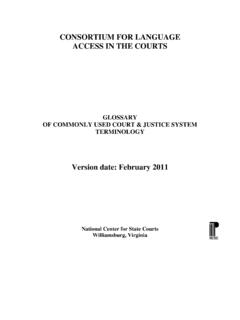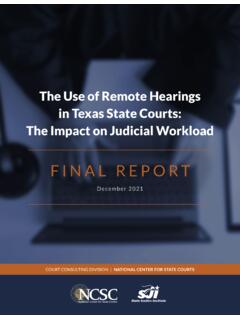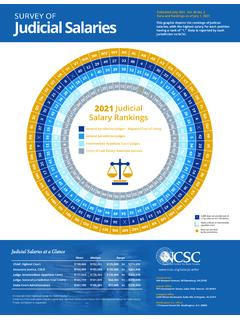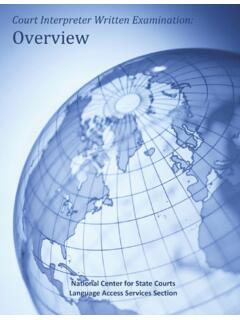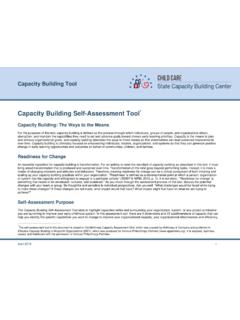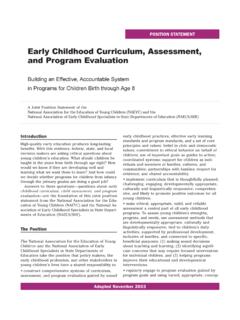Transcription of Offender Risk & Needs Assessment
1 Offender Risk & Needs Assessment Instruments: A Primer for Courts Pamela M. Casey Jennifer K. Elek Roger K. Warren Fred Cheesman Matt Kleiman Brian Ostrom This project was supported by Grant No. 2009-DG-BX-K030 awarded by the Bureau of Justice Assistance. The Bureau of Justice Assistance is a component of the Office of Justice Programs, which also includes the Bureau of Justice Statistics, the National Institute of Justice, the Office of Juvenile Justice and Delinquency Prevention, the SMART Office, and the Office for Victims of Crime.
2 Points of view or opinions in this document are those of the authors and do not represent the official position or policies of the United States Department of Justice. National Center for State Courts, 2014 Page ii Offender RISK & Needs Assessment INSTRUMENTS: A PRIMER FOR COURTS EXPERT PANEL MEMBERS Honorable Carl Ashley Milwaukee County Circuit Court Stephen A. Bouch Principal JS Bouch & Associates Sally Kreamer Director, Fifth Judicial District Iowa Department of Corrections Edward J. Latessa, Professor & Director School of Criminal Justice University of Cincinnati Geraldine Nagy, Director Travis County Adult Probation Randy K.
3 Otto, Department of Mental Health Law & Florida Mental Health Institute Honorable Ron Reinstein Judicial Consultant Superior Court of Arizona (Retired) Jacey Skinner Director Utah Sentencing Commission Faye S. Taxman, Professor Criminology, Law and Society Department George Mason University Gina M. Vincent, Assistant Professor, Department of Psychiatry Co-Director, National Youth Screening & Assessment Project Center for Mental Health Services Research University of Massachusetts Medical School Page iii TABLE OF CONTENTS Acknowledgements.
4 Iv Introduction .. 1 What are risk and Needs Assessment instruments, and why use them? .. 4 What are some examples of risk and Needs Assessment instruments; how do they differ? .. 8 What are the qualities of good risk and Needs Assessment instruments? .. 13 What practices support sound implementation of risk and Needs Assessment instruments? .. 20 What are the practical considerations in selecting and using risk and Needs Assessment instruments? .. 27 Conclusion .. 31 Notes & References .. 32 Appendix: Risk and Needs Assessment Instrument Profiles.
5 A-1 Page iv ACKNOWLEDGEMENTS The Primer benefited from the knowledge, counsel, and support of many individuals. Chief among these are the members of the Expert Panel who provided expertise and advice on a topic that continues to grow and evolve. Their combined knowledge of risk and Needs Assessment instruments and hands-on experience with criminal justice system reforms were significant assets to the effort. We also thank the test developers who patiently sat through our interviews and provided documents and other references for our review.
6 Their willingness to participate in the effort was crucial to understanding each instrument and ensuring our reviews are current. We also had the opportunity to discuss the use of various instruments with numerous judges, probation officers, and other criminal justice stakeholders we have met on our travels to different jurisdictions. We are grateful for their insights about and experiences with the various tools which have informed the Primer s suggestions and recommendations. Finally, we extend our appreciation to the many individuals from the Bureau of Justice Assistance, Office of Justice Programs, for their support of the project and their patience in seeing the project to completion.
7 Page 1 INTRODUCTION Why this Primer? During the last decade, the criminal justice field has focused intently on identifying programs and practices effective in reducing Offender recidivism and improving public Researchers and practitioners have worked together to determine what works best with which offenders and, as a result, have determined that the revolving door of recidivism is not inevitable; positive outcomes for both offenders and communities are Because of the effectiveness of these evidence-based programs and practices, their use has spread to all facets of the justice system from arrest to This Primer focuses on one of those decision points, sentencing, and on one of the tools, risk and Needs Assessment (RNA) instruments, critical to crafting sentences most likely to enhance recidivism reduction.
8 In 2011, the National Center for State Courts published a set of guiding principles, developed by a National Working Group of practitioners and researchers, for using Offender RNA information to inform sentencing decisions (Exhibit A).4 The report discusses why the information is critical to the sentencing decision, how the information should be used to inform sentencing decisions, and suggestions for effectively incorporating RNA information into the sentencing The guiding principles subsequently were endorsed by the Conference of Chief Justices and the Conference of State Court Administrators in a resolution.
9 Acknowledging that research has demonstrated that the use of validated and reliable Offender risk and Needs Assessment information to inform supervision and treatment decisions is a critical component of effective strategies to reduce recidivism. 6 Specifically, the Conferences resolved to: Support the National Working Group s recommendation that Offender risk and Needs Assessment information be available to inform judicial decisions regarding effective management and reduction of the risk of Offender recidivism; and Endorse the guiding principles described in the National Working Group s report as a valuable tool for state courts in crafting policies and practices to incorporate Offender risk and Needs Assessment information in the sentencing process.
10 And Encourage state and local courts to review the guiding principles and work with their justice system partners to incorporate risk and Needs Assessment information into the sentencing process. EXHIBIT A. Page 2 Although judges and other stakeholders increasingly see the value of having this information available in the sentencing process, they also have questions about how the assessments are produced and whether they are reliable, valid and fair. This Primer is a resource to help judges and others involved in sentencing understand and make knowledgeable decisions about the value and use of an Assessment .
